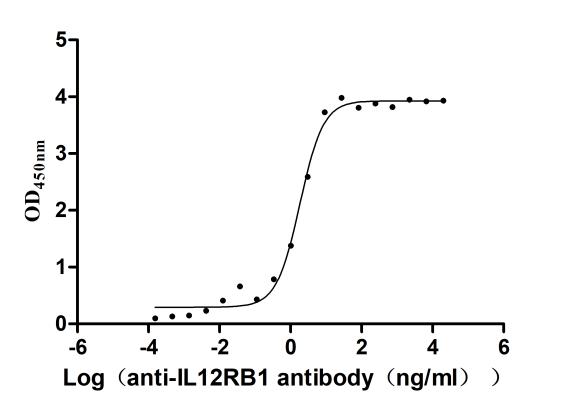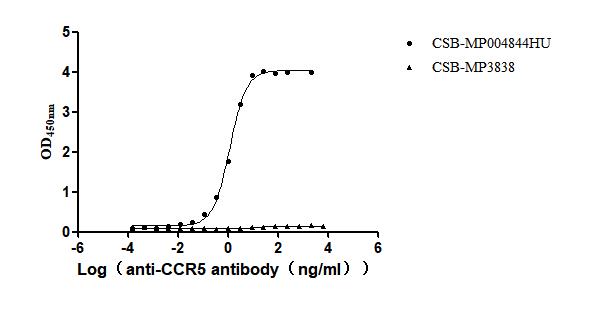Recombinant Salmonella typhimurium Cell invasion protein SipA (sipA), partial
-
中文名称:鼠伤寒沙门菌sipA重组蛋白
-
货号:CSB-YP317255SXB
-
规格:
-
来源:Yeast
-
其他:
-
中文名称:鼠伤寒沙门菌sipA重组蛋白
-
货号:CSB-EP317255SXB
-
规格:
-
来源:E.coli
-
其他:
-
中文名称:鼠伤寒沙门菌sipA重组蛋白
-
货号:CSB-EP317255SXB-B
-
规格:
-
来源:E.coli
-
共轭:Avi-tag Biotinylated
E. coli biotin ligase (BirA) is highly specific in covalently attaching biotin to the 15 amino acid AviTag peptide. This recombinant protein was biotinylated in vivo by AviTag-BirA technology, which method is BriA catalyzes amide linkage between the biotin and the specific lysine of the AviTag.
-
其他:
-
中文名称:鼠伤寒沙门菌sipA重组蛋白
-
货号:CSB-BP317255SXB
-
规格:
-
来源:Baculovirus
-
其他:
-
中文名称:鼠伤寒沙门菌sipA重组蛋白
-
货号:CSB-MP317255SXB
-
规格:
-
来源:Mammalian cell
-
其他:
产品详情
-
纯度:>85% (SDS-PAGE)
-
基因名:sipA
-
Uniprot No.:
-
别名:sipA; sspA; STM2882; Cell invasion protein SipA; Effector protein SipA
-
种属:Salmonella typhimurium (strain LT2 / SGSC1412 / ATCC 700720)
-
蛋白长度:Partial
-
蛋白标签:Tag type will be determined during the manufacturing process.
The tag type will be determined during production process. If you have specified tag type, please tell us and we will develop the specified tag preferentially. -
产品提供形式:Lyophilized powder
Note: We will preferentially ship the format that we have in stock, however, if you have any special requirement for the format, please remark your requirement when placing the order, we will prepare according to your demand. -
复溶:We recommend that this vial be briefly centrifuged prior to opening to bring the contents to the bottom. Please reconstitute protein in deionized sterile water to a concentration of 0.1-1.0 mg/mL.We recommend to add 5-50% of glycerol (final concentration) and aliquot for long-term storage at -20℃/-80℃. Our default final concentration of glycerol is 50%. Customers could use it as reference.
-
储存条件:Store at -20°C/-80°C upon receipt, aliquoting is necessary for mutiple use. Avoid repeated freeze-thaw cycles.
-
保质期:The shelf life is related to many factors, storage state, buffer ingredients, storage temperature and the stability of the protein itself.
Generally, the shelf life of liquid form is 6 months at -20°C/-80°C. The shelf life of lyophilized form is 12 months at -20°C/-80°C. -
货期:Delivery time may differ from different purchasing way or location, please kindly consult your local distributors for specific delivery time.Note: All of our proteins are default shipped with normal blue ice packs, if you request to ship with dry ice, please communicate with us in advance and extra fees will be charged.
-
注意事项:Repeated freezing and thawing is not recommended. Store working aliquots at 4°C for up to one week.
-
Datasheet :Please contact us to get it.
靶点详情
-
功能:Actin-binding protein that interferes with host cell actin cytoskeleton. It stimulates actin polymerization and counteracts F-actin destabilizing proteins. Potentiates SipC activity; both are required for an efficient bacterial internalization. In vitro, forms a complex with host cell protein T-plastin increasing actin bundling. It inhibits ADF/cofilin-directed depolymerization both by preventing binding of ADF and cofilin and by displacing them from F-actin. Also protects F-actin from gelsolin-directed severing and reanneals gelsolin-severed F-actin fragments.
-
基因功能参考文献:
- Here the authors show that in macrophages SipA induces increased caspase-3 activation early in infection. PMID: 28630067
- The authors identified the tetraspanning membrane protein, p53 effector related to PMP-22 (PERP), as a Salmonella typhimurium SipA binding partner. PMID: 25486861
- cell invasion protein SipA PMID: 11677609
- SipA triggered mucosal inflammation in wild-type mice but not in NOD1/NOD2-deficient mice, thus SipA-driven activation of the NOD1/NOD2 signaling pathway as a mechanism by which the type III secretion system induces inflammatory responses. PMID: 22186610
- Ezrin is required for the apical cell surface localization of MRP2 during bacterial infection and is dependent on the effector protein SipA. PMID: 21899702
- in infection of intestinal epithelium SipA was responsible for early activation of caspase-3 which is required for SipA cleavage at specific recognition motif dividing it into 2 functional domains and activated SipA in a manner needed for pathogenicity PMID: 20947770
- imaged delivery of the Salmonella type III effector protein SipA/SspA into animal cells in real time PMID: 16107539
- Crystal structure of the SipA chaperone binding domain (CBD) consists of a nonglobular polypeptide as well as a large globular domain, both of which are necessary for binding to its cognate type III secretion chaperone, InvB. PMID: 16507363
- Results show that SipA has at least two separate functional domains, and suggest that during infection S. typhimurium requires delivery of SipA to extracellular and intracellular spaces to maximize pro-inflammatory responses and bacterial invasion. PMID: 17697195
- Data show that Salmonella SPI1 effector SipA persists after entry and cooperates with a SPI2 effector to regulate phagosome maturation and intracellular replication. PMID: 18005682
- rapid SipA induced actin polymerization, filament annealing and bundle formation due to molecular crowding can explain how Salmonella invades cells at molecular level PMID: 18076120
- Thus, SipA plays a more prominent role in induction of invasion-competent membrane ruffles by Salmonella lacking a full complement of SPI-1 effectors. PMID: 19046340
- These data indicate that S. typhimurium SipA induces expression of CXC chemokines through phosphorylation of IL-8-transcription regulatory proteins, JUN and p38MAK. PMID: 19114119
- Mutants lacking acrA, acrB, or tolC showed differential expression of major operons and proteins involved in pathogenesis, including reduced production of SipA, SipB, and SipC. PMID: 19411325
显示更多
收起更多
-
亚细胞定位:Secreted. Note=Secreted via the type III secretion system 1 (SPI-1 TTSS).
-
蛋白家族:SipA/IpaA family
-
数据库链接:
KEGG: stm:STM2882
STRING: 99287.STM2882
Most popular with customers
-
Recombinant Human Microtubule-associated protein tau (MAPT) (Active)
Express system: Mammalian cell
Species: Homo sapiens (Human)
-
Recombinant Human Interleukin-17A (IL17A) (T26A) (Active)
Express system: Baculovirus
Species: Homo sapiens (Human)
-
Recombinant Human Dickkopf-related protein 1 (DKK1) (Active)
Express system: Mammalian cell
Species: Homo sapiens (Human)
-
Recombinant Human Interleukin-12 receptor subunit beta-1(IL12RB1),partial (Active)
Express system: Mammalian cell
Species: Homo sapiens (Human)
-
Recombinant Human C-C chemokine receptor type 5 (CCR5)-VLPs (Active)
Express system: Mammalian cell
Species: Homo sapiens (Human)


-AC1.jpg)
-AC1.jpg)
-AC1.jpg)











